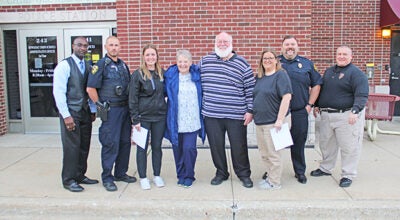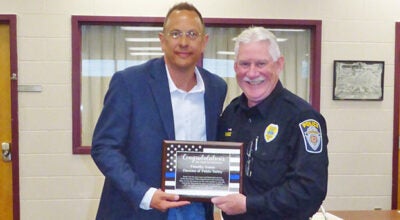Agri-terrorism a rural concern
Published 10:14 pm Wednesday, July 28, 2010
By JOHN EBY
Dowagiac Daily News

Kyle Miller
Miller, who will be attending Michigan State University this fall, was a member of the state-champion and U.S. runner-up parliamentary procedure team Cassopolis fielded.
Based on his public speaking performance at the state FFA convention in March, the former Cass County Fair king qualified for nationals this October in Indianapolis.
His July 28 talk accomplished two tasks — creating awareness of rural vulnerability to agri-terrorism attacks while helping him hone his “rusty” presentation by being peppered with planners’ questions.
Chair Barb Cook’s family and the Millers have been Pokagon Township neighbors since the 1800s.
Kyle shows cattle, hogs and sheep at the fair — and decorated cakes.
Last winter he stumbled upon his “scary” topic after considering the disappearance of honeybees.
He consulted a wide variety of sources to shape the attack scenario he shared with planners.
Millions of animals and crops destroyed by disease. Borders shut. Markets crash. America’s infrastructure crumbles.
Agri-terrorism, a form a bioterrorism, is the malicious use of animal or plant pathogens to cause devastating damage in the agricultural sector.
It has been a threat to the United States since development of biological warfare during World War I.
The U.S. ended its programs, but other countries, including Russia and Iraq, retain biological warfare storage facilities.
Miller said that spread-out and intertwined production enables bacteria or disease to spread, such as the 2007 salmonella in spinach from Salinas County, Calif., that affected 18 states before it could be detected and yanked off shelves.
Local pork producers, for example, who ship products all over the world, shudder at such nightmarish scenarios.
There are many levels of production on which an attack could occur, from slaughterhouses and packaging plants to storage bins and even at the store, but “the most vulnerable spot in agriculture is at the farm,” Miller said, “where animals are still alive to spread disease and plants are killed before they can be harvested.”
The main livestock fear is foot and mouth disease. Although tuberculosis, bovine spongiform encephalopathy (mad cow disease) SARS and avian influenza are other pathogens that could be used to attack, foot and mouth is easiest to spread and highly contagious.
It causes lesions on tongues, hooves and teats of cloven-hoofed animals, Miller related, leading to meat and milk production losses, abortions, even death.
Although eradicated from the United States, it remains a major issue in other countries.
“All it would take to introduce foot and mouth back into the U.S. is a contaminated article of clothing near livestock,” he said.
A simulation done by the assistant state veterinarian for North Carolina projected that if foot and mouth was introduced to five different locations across the nation, in two weeks it would spread to 44 states and cause destruction of more than 48 million animals.
Using numbers from the outbreak in Great Britain, it is projected a case of this magnitude would result in an economic impact of up to $235.4 billion, Miller said.
Crops loom as a large target because they are easily accessible near roads.
Miller mentioned an attack on the U.S. crop supply could reverberate around the world because America produces 46 percent of corn and 37 percent of soybeans.
Fungus and bacteria pose the biggest threat to crops, he said, because they can be spread by wind and water —both essential for plant survival.
Most fungus and bacteria thrive in specific climates during certain months.
“Strategic release” of these pathogens could destroy crops in a vast area.
In 1996, Karnal Bunt fungus affected wheat in the southwest United States, causing $200 million in lost exports.
Can it happen? To date, there have only been a few bio-terrorism attacks and no agri-terrorism attacks in the Unites States.
What’s to fear if there aren’t any terrorists so inclined?
Miller responds, “Government agencies have singled out agri-terrorism as a high-probability, high-consequence event. Former U.S. health and human services secretary, Tommy Thompson, in his retiring speech, said, ‘For the life of me, I cannot understand why terrorists haven’t attacked our food supply because it would be so easy to do.’
“After Sept. 11, 2001, the government increased anti-terrorism funding. However, it wasn’t until 2003 that President Bush brought forth the issue of protecting the United States food and fiber industry from a successful attack.
“Since 2001, the government has found that several of the 9/11 hijackers had agricultural training,” Miller said. “It is also known they expressed interest in crop dusting, which could be used spread disease to crops. U.S. forces have also collected intelligence in Afghanistan that al Qaeda has explored ways of damaging America’s food supply.”
U.S. agriculture produces more than $55 billion in exports yearly, making it a primary industry.
“Agriculture is one of the few industries with a positive trade balance, making it that much more important to America. We need to be prepared for the worst.”
Kansas is a leader in anti-agri-terrorism.
By hosting an International Symposium on Agri-Terrorism since 2005, the FBI, CIA and other agencies and universities can share with the world strides in preventing an attack.
One good idea to come of these meetings is Agri-Guard, similar to a neighborhood watch program, giving information on what to look for and to whom to report suspicious activity.
Miller said Michigan in 2007 became one of the first states to implement an Electronic Identification System (EIS) through Radio Frequency Identification tags (RFID).
These tags allow cattle to be easily traced back to their originating farm through the premise ID number each farm is given.
This will result is a quicker response time if an animal is found to have a disease.
Feb. 5 the U.S. Department of Agriculture ended its current work on developing a nationwide EIS because of “lack of support from producers,” he said. “They will work on developing a less expensive identification system to monitor interstate travel.”
Since biological pathogens that don’t directly harm humans are not defined as weapons of mass destruction, agri-terrorism is “not receiving the attention it should,” Miller said. “The FBI has conducted agri-terrorism drills.”
One at the University of Pennsylvania was planned for more than a year.
Drill participants were “in shock” how hard it was to set up a six-mile radius around the mock attack. “The FBI had difficulty after a year of planning. We cannot expect a local response to an attack to be successful without proper training. USDA receives only $40 million to use for education and awareness of agri-terrorism. To successfully respond to an attack more money needs to be shifted toward training these first responders.”
Response to an attack is important, but the key is prevention, in Miller’s opinion.
Prevention will not only rely on national, state and local officials, but, more importantly, individuals around agriculture — farmers, livestock truckers, FFA members and neighbors who can identify suspicious activity, sick animals and diseased crops.
“More emphasis needs to be put on to these individuals who will make the difference,” he said.
Jan. 24 al Qaeda leader Osama Bin Laden, threatened, “My attacks will continue as long as Americans continue to support Israel.”
“Until the United States improves funding to the prevention and awareness of agri-terrorism and trains first responders properly, America continues to remain vulnerable to a serious agri-terrorist attack,” Miller told an audience which also included a member of the Sheriff’s Office, county Emergency Management Coordinator Dave Smith and County Commissioner Ed Goodman, R-Silver Creek Township.
One planner left because her house was struck by lightning as storms rumbled through the southern part of the county.






